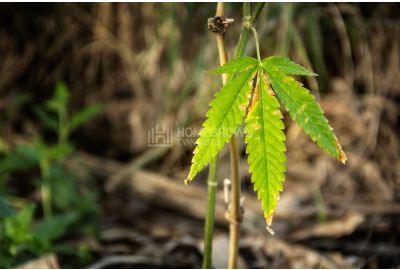How To Prevent & Fix Cannabis Nutrient Burn
Marijuana, like any other plant, needs four things to grow healthy and thrive—water, oxygen, sunlight, and nutrients. However, it's possible to have too much of a good thing. When your weed's nute intake, for instance, is beyond what it needs, an array of issues, including cannabis nutrient burn, can arise.
Novice cultivators often fall under the misconception that the more nutrients you feed a plant, the bigger and more fruitful it will become. Like a balloon pops under too much air pressure, a weed plant also has a maximum nutrient capacity.
Sometimes your feeding schedule isn't to blame at all, and other factors ruin the balance of your nutes, threatening your marijuana. Thankfully when spotted early and treated appropriately, nutrient burn on weed isn't fatal.
Join us as we unpack this common cultivating hiccup and explore what weed nutrient burn is and why it happens. We'll also share tried and tested methods on how to fix nutrient burn, alongside preventative measures to ensure your crop never falls victim again.
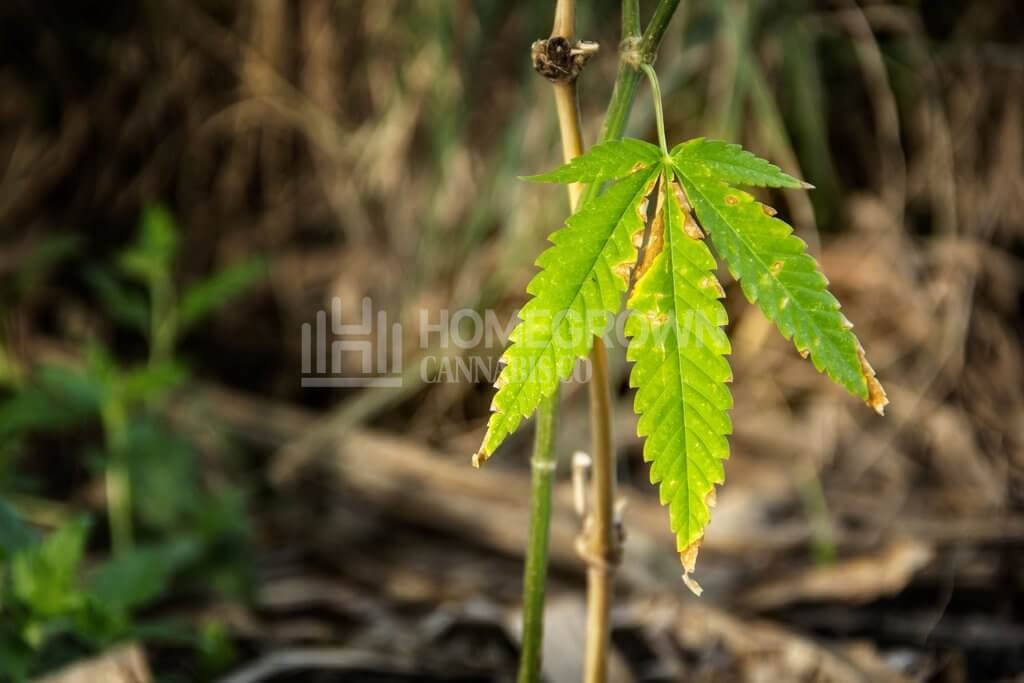
What is cannabis nutrient burn?
Weed needs three primary nutrients—nitrogen (N), phosphorus (P), and potassium (K)—known as macronutrients, in large quantities. Behind the scenes, they also require a host of micronutrients such as calcium, magnesium, and sulfur in trace quantities to grow healthy and strong.
The concoction of chemical compounds is comparable to a car engine. If one misfires, the entire system cannot run properly, triggering a chain reaction of damage. Plants can't control how much of a nutrient they absorb. They take in whatever you put down or is reachable in their environment, and when they overload on nutes, your weed suffers from nutrient burn.
Throughout the growing cycle, you need to provide a balanced and moderate amount of nutrients for your weed. The quantity needs to reflect the plant's stage of growth to avoid cannabis nute burn.
How bad can cannabis nutrient burn be?
Over fertilized cannabis causes severe distress to plants leading to discoloration, curling, and withering of leaves. Foliage is the energy source for your weed—think of each leaf as a small-scale solar panel. Therefore, any damage to them has a significant impact on overall plant health.
Crops with an abundance of one or more nutrients may also lock out others, making them unable to absorb the necessary quantities to continue to grow. You must diagnose and treat marijuana nutrient burn fast before you also have a nute deficiency on your hands.
Cannabis nutrient burn can occur at any stage throughout your weeds lifecycle. Seedlings and young plants are most at risk of the issue becoming fatal. Older crops are more likely to survive the mistake but with scars of stunted growth and a reduction in yield potential.
Nutrient burn in seedlings
Nutrient burn at the seedling stage is a complication most beginners diagnose incorrectly. Your crop typically doesn't need feeding until 3 or 4 sets of true leaves have grown, making nute burn on cannabis seem an impossible cause when illness hits.
The soil or growing medium you chose to transplant your germinated seeds into is most likely to blame for cannabis nutrient burn symptoms at this phase. The home cultivator community calls this threat' hot soil', meaning the medium is bursting with too many nutrients for such a young plant.
The good news is unless the case is severe, most seedlings grow out of it as they mature and their intake increases. Be sure not to add any more nutrients until the situation has balanced out.
Nute burn during veg
Learning the appropriate levels of nutrients your weed needs at different stages of growth is vital in becoming a successful cultivator. It's the most effective and cheapest preventative measure you can take.
As your weed cycles into the vegetative stage, you need to increase its nitrogen intake but lower phosphorus and potassium. Overdoing it and nute burn during the veg phase stunts your plants' top growth, reducing the number of nodes it has for flowering.
If cannabis nutrient burn strikes, consider keeping your weed in this phase while you treat the issue and allow the plant to make up for lost time. Suspending your crop in the vegetative stage won't harm them. If you're cultivating an autoflower strain, sadly, this isn't an option, and a low yield is most likely unavoidable.
Nutrient burn during flowering
When your crop flips into flowering, your plants focus on bud development rather than growing and repairing leaves. The change means they're much more vulnerable to health issues like nutrient burn on cannabis.
You'll need to feed more phosphorus, potassium, and calcium but drop nitrogen levels dramatically to avoid nutrient burn during flowering stage. If you fail to do so, the build-up can cause your buds to taste like chemicals and be unpalatable, spoiling all your efforts.
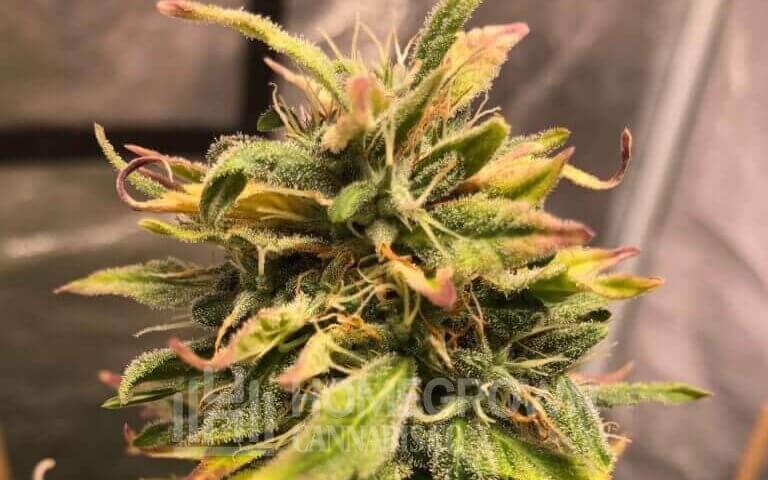
Nute burn late in flowering
With harvest around the corner and all energy going into fattening out buds, your weed finds it hard to recover from nute burn late in flowering. It's crucial you monitor your crop closely at this point for any early signs of struggle.
If leaves are left to wither and die from nute burn on cannabis, it's unlikely your plant will attempt to replace them—losing a valuable source of energy. If too many leaves are lost, yield size becomes less than impressive.
It can be very easy to trigger nutrient burn during flowering, especially when adding fertilizers into water. The key is to get the balance right while you increase your crops' watering schedule. Remember that each strain of marijuana has different requirements during this last phase.
For the last few feeds before harvest, only use pure water to flush any residual nutrients from the buds. Nugs plump with leftover nutes taste disappointedly awful.
What causes fertilizer burn?
Opposite to a deficiency, nute burn is most frequently caused by overfeeding cannabis rather than a lack of nutrient availability. The simple human error is common if you don't follow your weed needs appropriately at each growth stage. Accidents can also happen when you provide your plants with unbalanced resources like water and soil.
What causes fertilizer burn when overfeeding isn't the case? There are a handful of other causes of nute burn, including:
- 'Hot' growing medium - An abundance of nutrients in potting or ground soil can make it too rich, aka 'hot' for your pot to handle. The usual culprits for the high levels are fresh manure and artificially nutrient-loaded store-bought soil mixes.
- Overwatering - A saturated growing medium prevents oxygen from reaching your plant's root system. Without this access, processes like nutrient absorption get thrown out of sync. Weed needs a dry period in the watering schedule to function efficiently.
- Low light - Without adequate lighting, cannabis plants can't drive vital physiological processes to create energy. Poor levels significantly increase the risk of weed nutrient burn—even if you feed low-strength formulas.
- Growth stimulants - If you want colossal weed plants, growth stimulants might sound like the ideal option. However, using them too often ironically causes dwarfism, alongside heavy cannabis nute burn.
- Dry soil - Yes, a dry period is crucial to include in your weeds watering cycle, but if your soil dries out, too much nutrient salts build up. When you next come to water, you'll flood the soil with a tsunami of nutrients as they all mobilize at once. As a result, your weed will encounter a large and sudden uptake of nutes burning in the process.
- Bloom boosters - Commercial fertilizer mixes advertised as bloom boosters are formulated to give plants everything they need to produce more flowers. Using them too often or with a high concentration during flowering can cause a severe case of nutrient burn on weed when it's most vulnerable.
What are the signs of fertilizer burn?
Over fertilized weed plants don't suffer in silence; they quickly show varying signs of distress depending on the severity when something isn't right.
Early warning signs of fertilizer burn include:
- Leaves turn a deep green color.
- Leaves begin to bend at the tips.
- Tips of the leaves turn slightly yellow or brown.
Although subtle changes, these alerts are important to look out for. They signal a build-up of nutes in your weed before burning jeopardizes long-term health.
Nutrient burn on cannabis always starts at the tip of the leaves. Your plants will attempt to shift the excess nutes by sending them to the furthest points. Here the nutrients settle and burn the leaves. It's crucial you monitor leaves carefully for any signs of stress to catch marijuana nutrient burn early.
If left to progress, damage moves from the tip inwards across the leaf, taking hold of it until it dies and falls off.
Advanced cannabis nute burn, which needs immediate action, looks like:
- Brown or yellow discoloration that's spreading around the edges of leaves.
- A yellow halo-like shape separates the burnt edges from the healthy tissue at the center of the leaf. Over time the halo shrinks in size.
- Leaf edges curl under.
- Leaves twist and become deformed.
In some cases of nutrient burn on marijuana, particular symptoms are an indication as to which nute is to blame. Curling leaves, for instance, are the calling card of nitrogen toxicity.
The tricky thing is many cannabis nute burn symptoms are similar to other illnesses such as nutrient deficiency, pests, and disease. You must identify the issue correctly before attempting to remedy it. If you go ahead and pump more nutes into your weed thinking it has a deficiency, you're only going to worsen the problem.
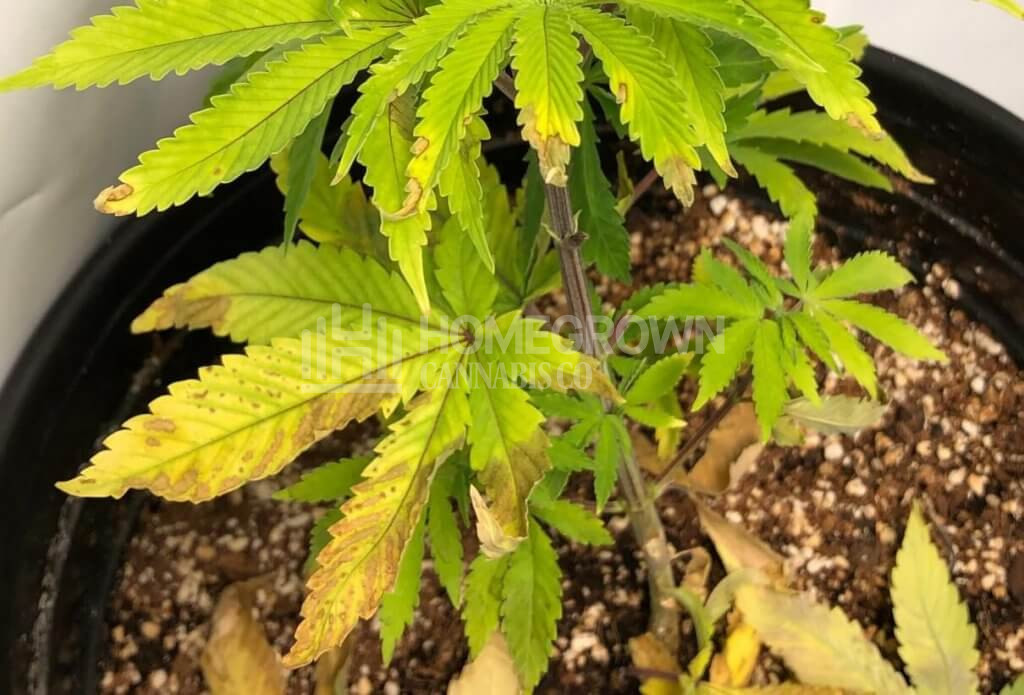
How to fix nutrient burn on weed plants
Plants can recover from fertilizer burn quickly. The key is to diagnose the issue fast and put the appropriate after-care treatment in place.
It's time to learn how to fix nutrient burn on weed plants so you can get your crop back in tip-top shape before harvest rolls around.
- Flush out the soil - Consider your soil or potting media a pantry for your plant where nutrients are stored. The first step to fixing a nutes overload is to empty that stockpile by flushing it out. Use clean, pH-balanced water to irrigate the media. If you're using a reservoir, measure what's left with a pH/EC meter and top it up with pure water until levels are even.
- Remove damaged foliage - Dead or dying leaves still hanging onto your plant waste its energy and eventually rot, attracting pests. It's best to remove any damaged foliage so your weed can focus on healing.
- 'Dial down' fertilizers - Less is often more with cannabis. When signs of cannabis nutrient burn start, dial back the amount you feed. After the problem subsides and you return to regular feeding, use only ¾ of the recommended strength to prevent further burning.
- Try a plant tonic - Specialized plant tonics are a great idea to help nurse your cannabis back to health. Opt for formulas that target the root biosphere and contain vitamins, minerals, silver nitrate, and humic and fulvic acids.
Dealing with marijuana nutrient burn in hydroponics
If you're searching for specific information surrounding how to reverse fertilizer burn in hydroponic setups, look no further. At the top of the to-do list is to adjust the levels in your reservoir using pH-balanced water. In severe cases, draining the reservoir may be your only option.
To regulate the electrical conductivity, cycle the freshwater for around 24 hours, testing the nutrient and salt levels regularly. If the soil in your system is to blame for cannabis nutrient burn, lower the concentration of the fertilizer present in the media by flushing the system.
Indoor hydroponic cultivators also need to keep a close eye on their lights. Poor lighting can quickly lead to cannabis nutrient burn and significantly stunted growth as a result.
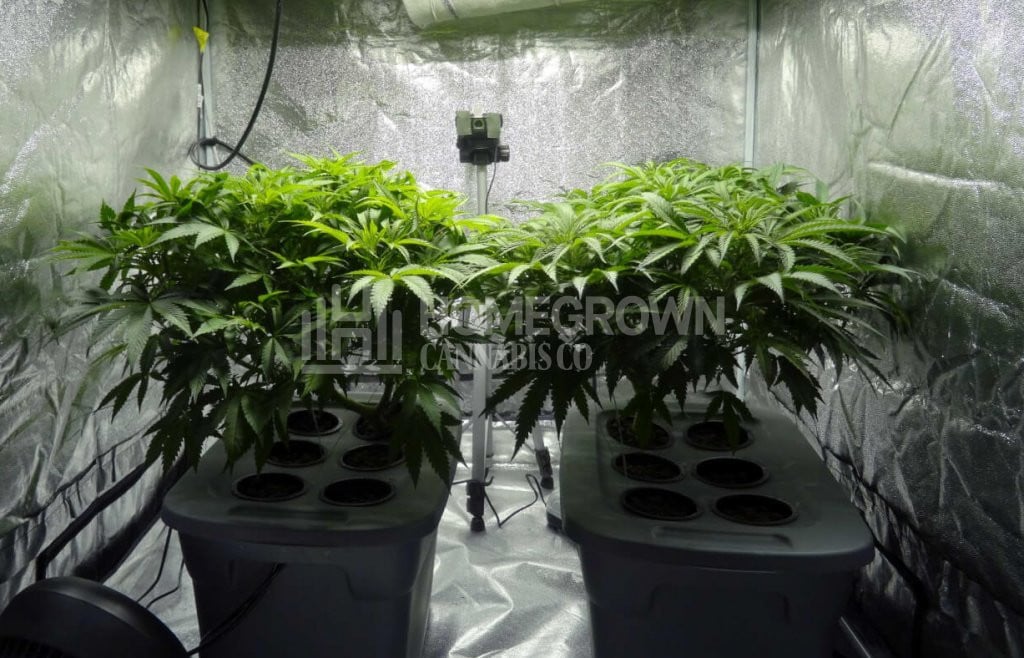
Dealing with cannabis nutrient burn in soil
To help over-fertilized cannabis grown in soil recover, irrigate the media with pH-balanced water until it runs through the drainage. You need to repeat this numerous times to flush any nutrient build-up out.
Once your plant's environment is free of excessive nutes, hold off feeding your weed until tests show the soil has returned to normal levels. Continue fertilizing too soon, and cannabis nute burn will recur.
Will plants recover from nute burn?
With early intervention and appropriate treatment, your plants will recover from nute burn. Short bouts aren't deadly and won't necessarily ruin your chances of a prosperous harvest. Crops left to suffer for too long may survive, but long-term illness dramatically reduces plant size and final yield weight.
One of the most beneficial ways you can help your plants recover from cannabis nutrient burn is to strip them of any damaged foliage, including buds. The approach is similar to pressing the reset button—encouraging the plant to focus its energy. It also prevents parts that will never turn back green from causing further health complications as they rot.
How to avoid cannabis nute burn?
In any scenario, prevention is always better than the cure. Fixing issues as they arise rather than avoiding them costs more money and time than putting in preventative measures from the get-go.
As you set up your grow space, decrease the chances of mistakes leading to cannabis nutrient burn by using the techniques below.
- Use a feeding chart - Different cannabis strains react uniquely to fertilizers, requiring more or less specific nutes at each point of their life cycle. Novice growers and veterans working with a new cultivar will find they have to do some experimenting to get the levels right.
Use a nutrient dosage chart to guide your decisions but consider the figures as maximums. Feed only 50% to start with and gradually build up the concentration while carefully monitoring any early signs of nutrient burn on weed.
- Keep a diary - Have a notebook in your grow space at all times to record important data, such as how much fertilizer you're putting down for your pot. When signs of fertilizer burn occur, review your notes and 'dial down.'
- Opt for cannabis-specific nutes - Specifically designed nutrients for cannabis are a much better choice for your crop than generic garden fertilizers. The solutions are tailored to the species' needs, and many products support the different growing cycle phases.
- Adapt to the different stages - It's vital you adjust your feeding schedule to appease the nutritional demands of your weed at every phase of its life cycle. Fail to give your plants what they need and when, and you'll face a whole host of problems, including cannabis nutrient burn.
- Monitor PPM and EC - Prevent nutrient burn on weed by monitoring the parts per million (PPM) and electrical conductivity (EC) of your feeding mix and its runoff closely. You'll need a total dissolved solids (TDS) meter to collect the values. This handy bit of kit provides an invaluable insight into the nutrient levels present in your formulas and growing media.
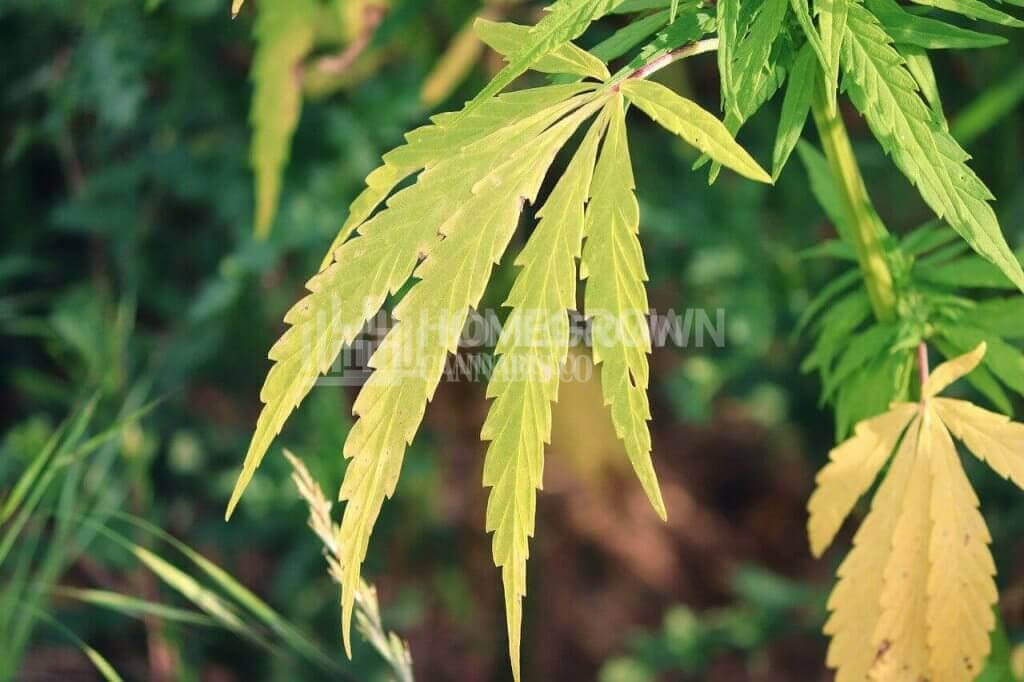
Say no more to nutrient burn
Don't fall victim to the misconception that bulking your weed out with nutes will yield bigger and better results. The truth is overindulging them will have the opposite effects—damaging your plants from the inside out, disrupting their growth, and causing marijuana nutrient burn.
Like light, humidity, and temperature, balancing marijuana nutrition is a key element of cannabis cultivation. As the plant matures, you need to adapt to its needs and adjust what you provide. Keep a close eye out for signs of cannabis nutrient burn and regularly check your pot's environment using a TDS meter for any discrepancies that could lead to harm.
Early detection of cannabis nute burn is essential to your marijuana recovering without any long-term health complications that would impact final yield size. Using preventive measures from the get-go will reduce the risk of human error leading to nute burnt over-fertilized cannabis.
It's crucial to remember that there isn't a one-size-fits-all rule for nutrient quantities and every cannabis plant is unique. Each strain and even plant of the same cultivar is different and responds to nutrients differently. When signs of fertilizer burn appear, act fast by dialing down your feeding, strip back affected foliage, flush your cannabis media, and grab your TDS meter.
For more handy information on how to prevent and treat common cannabis illnesses, check out our blog on all things marijuana.
About the author: Derek LaRose
Also known as Kronic from The Cannabis Kronicles, Derek LaRose is a young ambitious cultivator and a staple educator for indoor cultivation.
